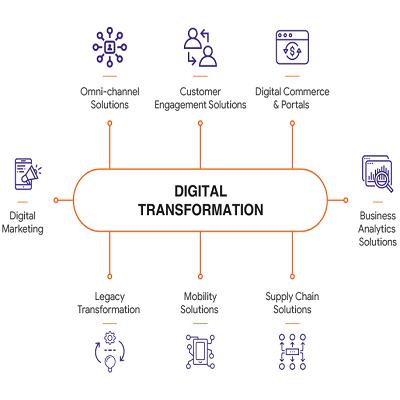Digital Transformation: Empowering Businesses for the Future
In today’s fast-paced world, businesses are constantly striving to stay ahead of the competition. One of the most impactful ways to achieve this is through Digital Transformation. This process involves integrating digital technologies into all areas of a business, fundamentally changing how it operates and delivers value to customers. Digital transformation isn't just about upgrading systems or adopting new technologies – it's a cultural shift that impacts every aspect of the business, from internal processes to customer interactions.

What is Digital Transformation?
Digital transformation is the process of using digital technology to solve traditional problems, optimize workflows, and enhance customer experience. It’s more than just implementing new software or switching to cloud computing. It requires a comprehensive approach that aligns digital tools with business goals, customer needs, and innovative practices. Whether it's automating mundane tasks, leveraging big data for decision-making, or creating new digital products, digital transformation can drastically improve efficiency and competitiveness.
Key Drivers of Digital Transformation
- Technological Advancements: Rapid advancements in technologies like artificial intelligence (AI), machine learning, Internet of Things (IoT), cloud computing, and blockchain are at the heart of digital transformation.
- Customer Expectations: Consumers expect seamless, fast, and personalized experiences. Businesses must adapt by using digital tools to meet these high expectations.
- Competitive Pressure: Companies must innovate continuously to stay ahead of the competition. Digital transformation is essential for organizations looking to differentiate themselves.
- Globalization: With the world becoming increasingly interconnected, businesses must adopt digital strategies to remain competitive in the global marketplace.

Benefits of Digital Transformation
- Improved Customer Experience: Digital transformation enables businesses to offer personalized services, quicker responses, and a more convenient overall experience.
- Increased Efficiency and Productivity: Automation and data analytics streamline decision-making processes, reducing manual tasks and improving resource management.
- Better Decision-Making: Data-driven approaches enable businesses to make informed decisions, enhancing agility and responsiveness.
- Cost Savings: While the initial investment can be high, digital transformation leads to significant cost savings in the long run through automation and optimized processes.
- Innovation and New Business Models: Businesses can leverage digital tools to innovate, create new products, and develop new business models.
Challenges in Digital Transformation
- Resistance to Change: Employees may resist the adoption of new digital technologies. Overcoming this resistance requires strong leadership and clear communication.
- Legacy Systems: Migrating to new digital platforms from outdated systems can be challenging, especially in large organizations with complex infrastructures.
- Cybersecurity Risks: As businesses become more digital, they face greater cybersecurity threats. Protecting data and systems is essential during digital transformation.
- Skills Gap: The rapid pace of technological change requires businesses to invest in upskilling their workforce to manage and implement digital tools effectively.

Steps for Successful Digital Transformation
- Define Clear Goals: Set clear objectives aligned with your business strategy to ensure the digital transformation addresses key business needs.
- Adopt a Customer-Centric Approach: Ensure that the transformation focuses on improving the customer experience, whether online or offline.
- Invest in Technology: Choose scalable and innovative technologies such as cloud solutions, data analytics platforms, and AI that align with your business goals.
- Empower Employees: Provide training and create a culture of innovation to help employees adapt to new technologies.
- Monitor and Optimize: Regularly track progress, measure results, and adjust strategies to ensure the transformation is on track and effective.
Conclusion
Digital transformation is no longer a luxury but a necessity for businesses looking to thrive in the digital age. By leveraging the power of technology, companies can improve customer experience, streamline operations, and unlock new opportunities for growth and innovation. The potential benefits of digital transformation far outweigh the challenges. Embracing change is the key to remaining competitive and ensuring long-term success in an ever-evolving marketplace.
